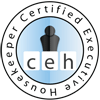Some sinks are made of tough stuff and can take a vigorous scrubbing with abrasive cleansers and tools. Use the same methods on others, however, and you risk scratching or ruining its surface. The following cleaning and care tips are based on materials:
Acrylic
Liquid dishwashing detergent and a damp cloth will clean an acrylic sink well. Abrasive pads and scouring powders may be used on matte surfaces only. Periodically buff the entire surface of a matte sink with a Scotch-Brite®-type nylon pad to ensure uniform appearance if any abrasive products have been used on it. Don’t use anything abrasive on a semi-gloss or high-gloss sink. Glossy sinks need to be restored by a professional if they become scratched or dull.
Don’t let strong chemicals remain on an acrylic sink surface for long. Acids and alkalis such as drain cleaner, oven cleaner and toilet cleaners can leave permanent chalking on acrylic. A hot pan or pot placed on the surface may lead to permanent yellowing.
Brass
Lacquer generally isn’t used to protect brass sinks, so the sink will tarnish over time. Wiping the sink dry after every use will reduce tarnishing. Use brass polish to remove tarnish and restore the shine, following all label instructions. Harsh abrasive pads and scouring products can scratch the surface — do not use them. Once polished, consider applying a non-abrasive car wax or finish to help maintain appearance. As with automotive paint, re-apply the finish as soon as water stops beading up on the brass.
Avoid spilling or pouring harsh chemicals into a brass sink. This includes ammonia, liquid bleach or drain cleaners. Promptly flush the sink with plenty of clean water to rinse away any of these chemicals. Storing any of these chemicals in open containers under the sink may result in long-term corrosion from vapors. In addition, certain foods — citrus and fruit juices, mustard, pickles and pickle juice and mayonnaise — can pit brass if allowed to remain on the surface.
Corian®
Made by DuPont, this composite surface may be cleaned with soap, liquid dishwashing detergent, or ammonia-based cleaners.
Never mix cleaning chemicals, but for stains, wipe the sink with a soft cloth moistened in a solution of liquid bleach diluted in water, and then rinse thoroughly and wipe dry.
Minor scratches may be removed from matte-surface sinks with a Scotch-Brite®-type scouring pad. Wipe the pad in a circular motion over the entire sink to restore the finish. This method is not recommended for semi-gloss or high-gloss sinks; use countertop polish instead. Consult a professional to restore glossy surfaces that have dulled.
Use care when pouring boiling water into a Corian sink. Run cold tap water at full strength while discarding boiling water. Avoid pouring or spilling strong chemicals such as oven cleaner, drain cleaners, nail-polish remover, turpentine or paint thinner into a Corian sink. If this happens, immediately flush the sink with plenty of clean water.
Enameled metal
Enameled sinks may be found in either the kitchen or bath. Coats of enamel paint are “baked” onto a steel or cast-iron sink at high temperatures. Enamel is a long-lasting finish, but it’s not indestructible. Abrasive cleansers and pads will scratch the enamel and can strip it right off the metal if applied with lots of “elbow grease.” Use hand dishwashing liquid or liquid household cleaner applied to a sponge or rag. Soak dried food off the surface by placing a wet sponge or cloth on it for several minutes. Scrub with a white nylon-colored pad only when necessary.
Avoid dropping heavy or sharp objects into your sink. Doing so may chip the enamel, exposing the underlying metal to rusting. A corroded sink eventually must be replaced since rust-through holes cannot be repaired.
Granite
Most “granite” sinks are a composite of the durable stone and acrylic resins. Clean granite sinks regularly — daily, in the case of a kitchen sink — with soapy water on a nylon brush or white nylon pad. Rinse the entire sink thoroughly, and then dry well. This helps prevent the buildup of mineral scale, particularly in areas with hard water. Don’t use abrasive pads or scouring cleansers, which will scratch the surface, leaving it dull and more susceptible to future stains.
Remove tough spots with dishwashing liquid, diluted bleach (never mix chemicals) or a paste of low-abrasive cleanser such as Soft Scrub® or Bon Ami® and water. A cloth or paper towel soaked in white vinegar will remove mineral spots and scale if allowed to remain in place on the deposits for no more than 30 minutes at a time. Always rinse and dry the sink thoroughly after using any cleaner.
Avoid using ammonia and other strong alkalis such as drain cleaner in a composite granite sink. Flush any spills promptly with plenty of water.
One-piece (also known as “solid surface”)
One-piece sinks are usually found in bathrooms. In normal use, these sinks may be cleaned with warm water and a mild detergent, such as dishwashing liquid. Abrasive cleansers may be used occasionally on matte finishes, but avoid applying too much pressure while scrubbing. Apply abrasive cleanser onto a nylon pad and buff out minor scratches and burns using a circular motion.
Solid surface sinks can be stained permanently or damaged by exposure to strong chemicals. Avoid pouring or spilling oven cleaner, drain cleaners, nail-polish remover, turpentine or paint thinner onto a solid surface. If this happens, immediately flush the sink with plenty of clean water.
Porcelain
Clean using products such as hand dishwashing liquid or an all-purpose cleaner. Use mild abrasives only when necessary — a white nylon-colored pad and a cleanser such as Bon Ami or Soft Scrub should be sufficient to clean up stubborn soils and most spots. Harsh pads and cleansers applied with excessive pressure can permanently scratch porcelain. Porcelain roughened in this way will be harder to keep clean in the future.
A true China sink can be cracked easily, just like a toilet bowl, so avoid dropping heavy or sharp items into a bathroom sink made of porcelain.
Fragile porcelain sinks generally aren’t installed in kitchens. See the entry for enameled steel instead.
Stainless Steel
Stainless steel provides a durable surface that can stand up to heavy use in the kitchen. Use soap or a low-abrasive cleanser such as Bon Ami or Soft Scrub along with a gentle pad when cleaning a stainless steel sink. Harsh abrasive pads and scouring products can scratch the surface. Food scraps, soap scum and other soils adhere more readily to scratch-roughened surfaces, so you’ll have to apply even more effort (and you’ll leave more scratches, too) during future cleanings. Flush the surface with plenty of clean water after the last cleaning of the day to rinse away any remaining acids or salts, which can pit the steel surface.
Stainless steel has a tendency to streak and to show mineral deposits in areas with hard water. To prevent this build-up, wipe the sink dry after each use. Remove streaks and scale by soaking a paper towel in white vinegar and placing it on the deposits for up to 30 minutes. Remove the towel, flush the sink thoroughly and wipe the surface dry.
Heavy objects dropped into a stainless steel sink may leave dents in the metal.









